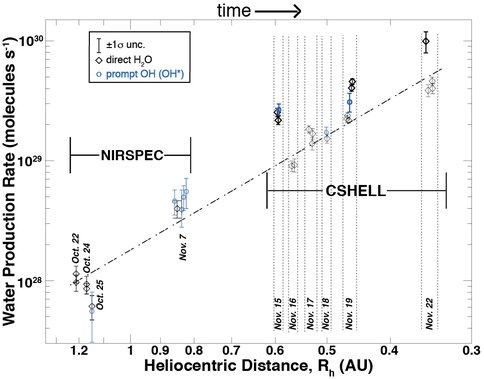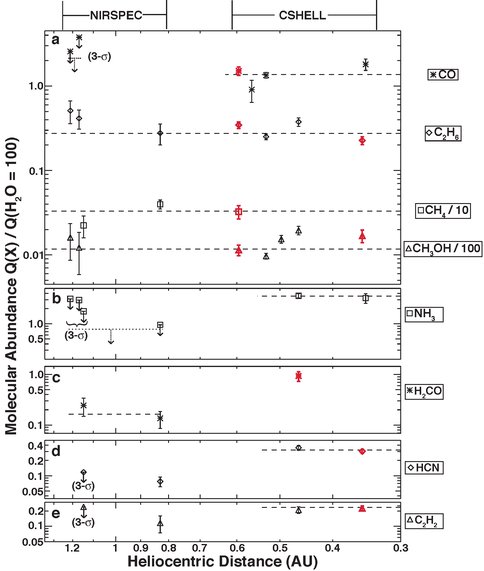2014 Annual Science Report
 NASA Goddard Space Flight Center
Reporting | SEP 2013 – DEC 2014
NASA Goddard Space Flight Center
Reporting | SEP 2013 – DEC 2014
Volatile Composition of Comets: Emphasis on Oxidized Carbon
Project Summary
DiSanti’s research emphasizes the chemistry of volatile oxidized carbon in comets, in particular the efficiency of converting CO to H2CO and CH3OH through reduction reactions on the surfaces of icy grains prior to their incorporation into the cometary nucleus. Additionally, oxidation reactions on grains can play a significant role, particularly for CO-enriched, C2H2-depleted comets such as C/2009 P1 (Garradd; see item 1 under Section 3 below). Such processes produce precursor molecules that (if delivered to Earth through impact of comet nuclei) could have enabled the emergence of life, and so are highly relevant to Astrobiology.
Project Progress
Two studies were completed in this reporting period:
(1) C/2009 P1 (Garradd): We measured the chemical composition of comet based on observations with the high-resolution infrared spectrograph (NIRSPEC) on the Keck 2 telescope (DiSanti et al. 2014, Icarus 228:167-180). This paper reported pre- and post-perihelion abundances for several molecules, and (pre-perihelion) quantified the fractions of H2O that were released directly from the nucleus and from a distributed source in the coma (Figure 1). The paper also suggested a means of testing the role of “redox” reactions in forming volatiles on precometary icy grains. Several volatiles detected in comets (e.g., H2CO) are species that play important roles in Astrobiology.
(2) C/2012 S1 (ISON): We measured the evolution with heliocentric distance (Rh) of H2O production, and of abundance ratios relative to H2O for eight molecules generally considered to be primary volatiles. We used NIRSPEC on four dates (a mini-campaign led by Mumma, with participation by Univ. Hawai’i, CalTech, and GSFC) and subsequently CSHELL on six dates (GSFC, led by DiSanti), as part of the world-wide observing campaign. The production rates of H2O obeyed a relatively steep heliocentric power law (Rh 3.2) between 1.2 and 0.35 AU from the Sun (Figure 2). The abundances of CO, C2H6, CH4 and CH3OH remained relatively constant with Rh, while those of HCN, H2CO, and NH3 increased dramatically, and that of C2H2 showed a modest increase within 0.5 AU from the Sun (Figure 3).
(3) C/2012 S1 (ISON): B. Bonev led an initial paper measuring the excitation of H2O vapor in the coma at Rh = 0.53 and 0.35 AU (Bonev et al. 2014, ApJ (Lett.) 796:L6). This demonstrated that high rotational temperatures were maintained away from the nucleus, and represents an important driver of complex thermal models of cometary atmospheres.
New observations acquired in this reporting period, using high-resolution infrared echelle spectrographs:
(4) C/2012 K1 PanSTARRS (Keck/NIRSPEC): Two half nights were awarded in May 2014 to observe Jupiter Family Comet 209P/LINEAR during its very close pass to the Earth, however the comet was much fainter than expected. Instead, spectra of C/2012 K1 were obtained. Multiple molecules were detected, and CO was constrained to about 2% or less. This was particularly significant for interpreting contemporaneous observations with the Spitzer Space Observatory.
(5) C/2014 E2 Jacques (Keck/NIRSPEC): M. DiSanti led observations on 2014 September 5 & 6. The comet was available for only 1 hour per night, but was bright enough to test the full suite of molecules except CO, which requires separate observations at longer wave-lengths. J. Keane led observations on September 16, as part of our collaborative effort between the Goddard and Univ. Hawai’i CAN-5 Teams. These emphasized simultaneous measurement of CO and H2O.
(6) C/2013 V5 Oukaimeden (Keck/NIRSPEC & IRTF/CSHELL): M. DiSanti led observations on 2014 September 5 & 6 (NIRSPEC), and September 10, 12, & 13 (CSHELL). For the NIRSPEC observations the comet was available for only the last 1.5 hours of the night, nonetheless the full suite of molecules (including CO) was sampled with NIR-SPEC. The CSHELL observations emphasized simultaneous measurement of CO and H2O.
Publications
-
Bonev, B. P., DiSanti, M. A., Villanueva, G. L., Gibb, E. L., Paganini, L., & Mumma, M. J. (2014). THE INNER COMA OF COMET C/2012 S1 (ISON) AT 0.53 AU AND 0.35 AU FROM THE SUN. The Astrophysical Journal, 796(1), L6. doi:10.1088/2041-8205/796/1/l6
-
DiSanti, M. A., Villanueva, G. L., Paganini, L., Bonev, B. P., Keane, J. V., Meech, K. J., & Mumma, M. J. (2014). Pre- and post-perihelion observations of C/2009 P1 (Garradd): Evidence for an oxygen-rich heritage?. Icarus, 228, 167–180. doi:10.1016/j.icarus.2013.09.001
-
Paganini, L., DiSanti, M. A., Mumma, M. J., Villanueva, G. L., Bonev, B. P., Keane, J. V., … Meech, K. J. (2013). THE UNEXPECTEDLY BRIGHT COMET C/2012 F6 (LEMMON) UNVEILED AT NEAR-INFRARED WAVELENGTHS. The Astronomical Journal, 147(1), 15. doi:10.1088/0004-6256/147/1/15
-
PROJECT INVESTIGATORS:
-
PROJECT MEMBERS:
Michael DiSanti
Project Investigator
Michael Mumma
Co-Investigator
Boncho Bonev
Collaborator
Erika Gibb
Collaborator
Karen Magee-Sauer
Collaborator
Lucas Paganini
Collaborator
Geronimo Villanueva
Collaborator
-
RELATED OBJECTIVES:
Objective 3.1
Sources of prebiotic materials and catalysts
Objective 3.2
Origins and evolution of functional biomolecules


